Can BMW’s innovative carbonfibre city hold its own against the GM’s range-extender?
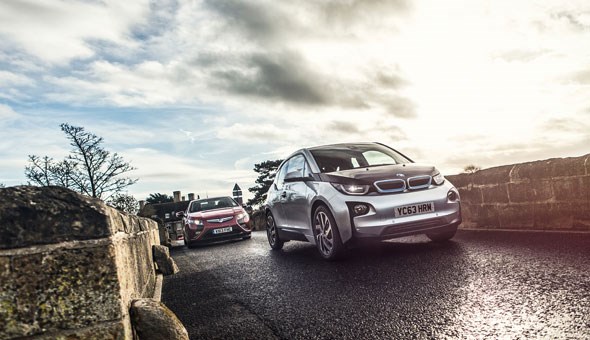
Churchill once regaled Parliament with the line: ‘History will show that my right honourable friend was wrong. I know this, because I shall write the history’. In effect, that’s exactly what BMW is having a crack at with its new i3. BMW has invested £2bn in its electric iCar programme, and if the £33,830 i3 Range Extender we’re driving finds enough showroom traction to take electric cars mainstream, Vauxhall will have a right to feel hard done by. The Ampera, a Focus-sized four-seater with a fabulously complex powertrain, has been on sale since 2011. It’s the British-badged cousin of the Chevrolet Volt, a tangible result of 2009’s US auto industry bailouts. Chevy parent General Motors has poured (US government) money into offering a viable range-extended vehicle, and in strolls BMW, late, overdressed, unashamed. Ready to make fuel-sipping nerdiness cool, like Harry Potter sending demand for trendy teenage specs into overdrive.
And the BMW i3 is cool. It exudes confidence. Approach its surprisingly bulbous, chic form with the bespoke, pancake-flat key in hand, and the i3 looks like it could be a dastardly villain from Disney’s Cars franchise. In the entire time I was driving the Vauxhall on this photoshoot, it only tore eyes away from the cartoonish i3 when uneasy onlookers wondered why a dreary sales rep was tailgating it.
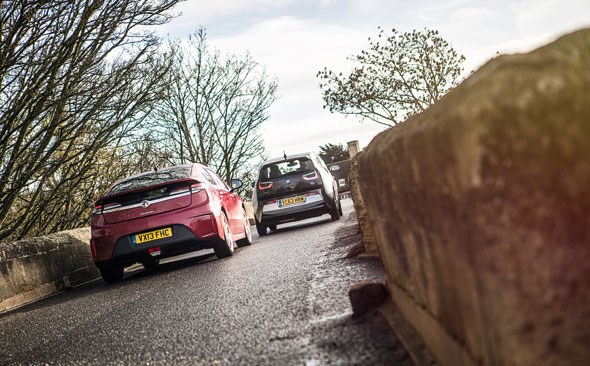
Ironically, beneath its slippery but painfully frumpy suit, the Ampera has the more innovative powertrain. Its front wheels are spun by a 148bhp electric motor, juiced by batteries that take 13 hours to charge. Not that you’ll ever run them completely down – the lithium-ion cells use only 65% of their capacity to maximise operational life. After a realistic range of 25-50 miles of silent torquey punch, the Ampera’s 1.4-litre, naturally aspirated four-pot petrol politely rouses, toiling as a battery power generator. Plus, there’s an extra 71bhp electric motor crammed under the bonnet. All three power sources are connected to the Ampera’s front wheels via a furiously complicated system of planetary clutches, magic, and sheer bloody-mindedness. Thanks, Obama.
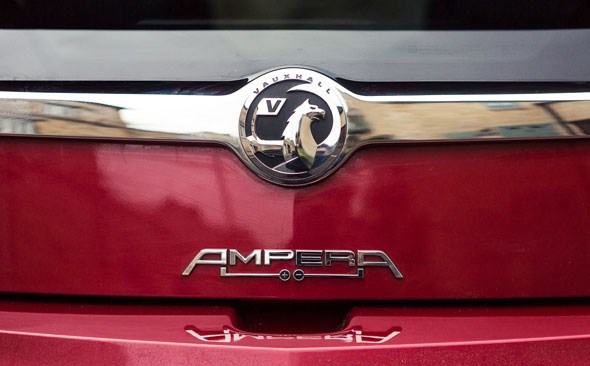
At motorway speeds, the e-motors work together for maximum efficiency, as long as cell-power allows. Nail the throttle, and the petrol motor clutches onto the wheels via a CVT ‘gearbox’. The upshot is you drive the Ampera like a normal car, with normal turbodiesel performance, and zero4 range anxiety. I have no doubt whatsoever the Ampera could slip unobtrusively into the lives of 50% of Insignia drivers, so long as they remembered to plug it in to charge every evening, as routinely as you do your smartphone. Then settle back and marvel at the fuel economy.
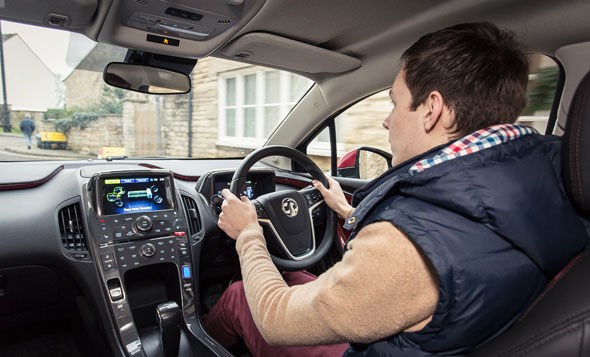
After spending a week tooling around in this particular Ampera, having suppressed my gag reflex to stomach the ghastly gloss trim inserts that wrap around the cabin, I averaged an easy 112mpg. And I cannot stress this enough – I wasn’t trying to drive economically. It’s simply the net result of all urban motivation coming petrol-free, and a brilliantly calibrated drivetrain keeping the combustion engine at low revs once it’s required.
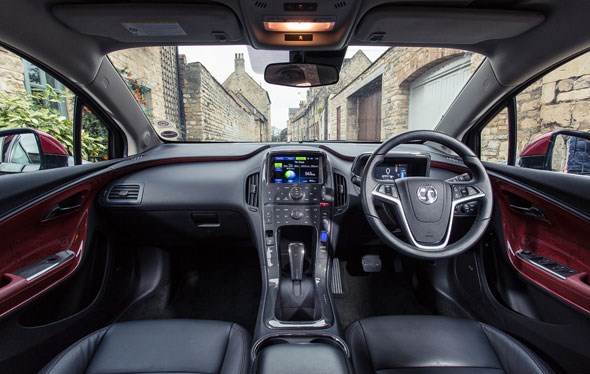
On paper, it’s in danger of making the BMW look rather ordinary. Buried amidst the i3’s carbonfibre, aluminium and plastic skeleton, there is no multifaceted hybrid-cum-electroboost witchcraft. You get a rearward 168bhp electric motor, good for up to 124 miles. Whereas that’d be game over in the all-electric i3, for £3150 extra, the Range Extender allows one more life. Beneath the VW Up-besting 260-litre boot, there’s a 647cc petrol two-cylinder engine from a BMW scooter. Its 34bhp and 41lb ft look pathetic, but the tiny twinnie never drives the i3’s enormous 19in footwear. It’s merely there as a last resort electricity generator, sucking petrol from a nine-litre thimble, extending battery range by another 86 miles. Enough to get this ostensibly electric car to another charging point, not swallow continents in a bound.
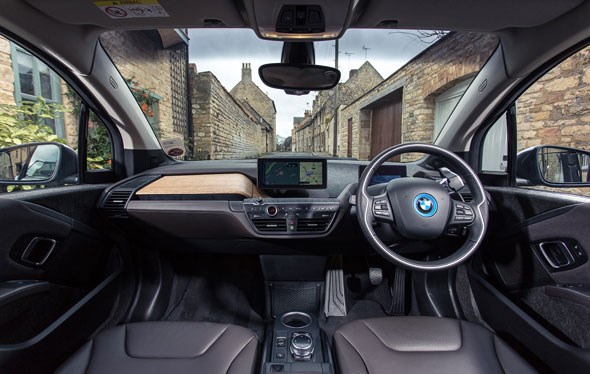
Despite a 120kg weight penalty over its purely electric twin, the rear-drive i3 Range Extender is still hilariously nippy. It rushes away from standstill with serious vigour on its way to 62mph in 7.9sec, though it feels faster thanks to instant 184lb ft torque gratification and seamless accelerative urge. And there you are, perched usefully high in a beautifully minimalist cabin that’ll seat four, swallow a week’s shopping, bait hot hatches at red lights and achieve, according to the EU driving cycle 11-plus, 470mpg. And you think: ‘BMW has well and truly nailed thi-… Christ, what’s that NOISE?’
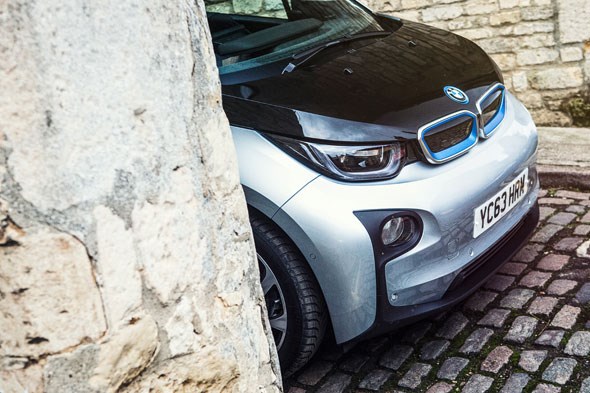
That’ll be the unsuppressed chug of the moped engine waking behind you, puncturing the ambience like Dom Joly’s oversized Nokia telephone at a funeral. BMW claims it didn’t fit the i3 RE with a bigger fuel tank to avoid compromising the packaging of the all-electric model. Didn’t want to suffer that buzz saw drone for more than 86 miles, more like. It’s even more audible outside, and completely at odds with the i3’s space-age demeanour. Imagine if your iPad emitted a gargling belch every time you unlocked it, rather than a crisp ‘click’. It’s that embarrassing.
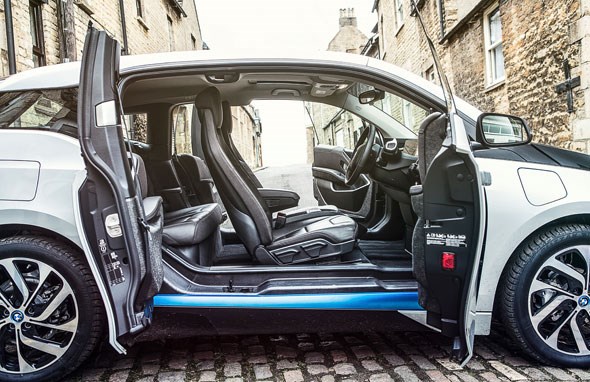
These cars intersect at a normal-car meets future-car crossroads. The Ampera longs to be taken seriously as a regular vehicle. The coach-doored i3 is a showpiece. The maroon machine drives like a regular auto, albeit one with a serious weight problem that’s evident via terminal understeer from the eco tyres if pushed, and a lack of brake-bite if more retardation than the regenerative charging offers is required. The i3 isn’t exactly an ultimate driving machine, but it does exhibit excellent traction, beautifully weighted, wrist-flick-quick steering, an agile chassis (thanks to that wheel-meets-corner stance) and a commendably fluent ride, given it wears footwear even Two Chainz (look him up) would think ostentatious.
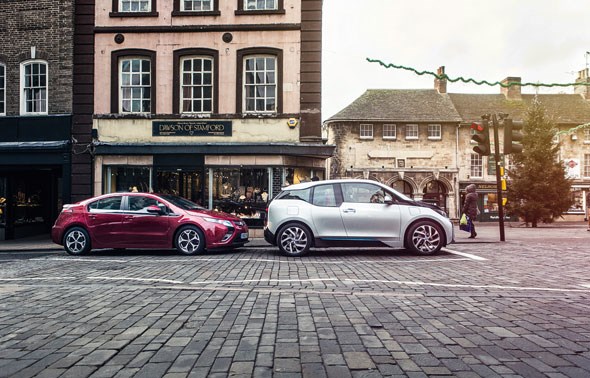
If you’re after a definitive victor, the i3 Range Extender easily wins this test. It’s faster and more fun to drive. It has a far more intuitive interior, boasts practicality superior to the Vauxhall and – before options – it’s cheaper. The Ampera is a tempting ownership proposition as an only-car, but it can’t compete with the i3’s mouth-watering desirability. If anyone is to make range-extenders the next big thing, it’ll be BMW, not GM. History is written by the victors, after all.
| |
BMW i3 Range Extender |
Vauxhall Ampera |
| Price |
£28,830 (after £5k government grant) |
£30,495 (after £5k government grant) |
| Engine |
168bhp, 184lb ft electric motor, plus 647cc 2-cyl, 34bhp, 41lb ft |
1398cc 16v 4-cyl, 85bhp, 93lb ft; plus synchronous electric motor, 148bhp, 273lb ft; and electric generator 71bhp |
| Gearbox |
Single-speed direct drive, rear-wheel drive
|
CVT, front-wheel drive |
| Performance |
7.9sec 0-62mph, 93mph, 470.8mpg, 13g/km CO2 |
8.7sec 0-62mph, 100mph, 235.4mpg, 127g/km CO2 |
| Weight/made from |
1315kg/carbonfibre and aluminium |
1689kg/steel |
| On sale |
Now |
Now |
| Verdict |
4 stars |
3 stars |
Words: Ollie Kew Photography: Richard Pardon
>> Now scroll down to see how the victorious BMW i3 compares with the world’s best-selling EV, the Nissan Leaf
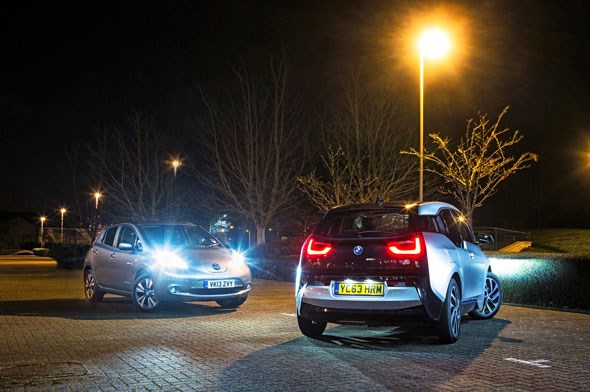
How does the i3 stack up against Nissan’s EV? The Leaf was tweaked for 2013, losing 77kg and gaining a 40-litre bigger boot, better cabin, and more supple suspension. It’s range also increased from 100 to 124 miles, a match for the i3. but still short of the i3 Range Extender’s 210 miles.
The Leaf is four seconds slower to 62mph than the i3, but it never feels tardy – these twist-and-go electric motors need to be sampled to be believed. The low centre of gravity from those floor-housed batteries mean it’s far from ungainly to hustle as well. The more conventional interior isn’t in the same league for design and quality as the i3’s, but the Leaf is way cheaper: you can snap one up from just £15,990, if you pay £70-a-month to lease the battery – which could equate to a month of fuel if you do the limited mileage typical of EVs!
However, knock the £5k grant off the top-spec Tekna and it’s £25,490 – £3340 less than the i3 Range Extender. If you’re sure you can live with the Nissan’s obvious compromises, it runs the classy i3 RE closer than you might assume. But the all-electric i3 is faster still, and only £190 more than the top-spec Leaf. I’d take that every time. OK